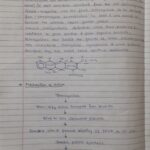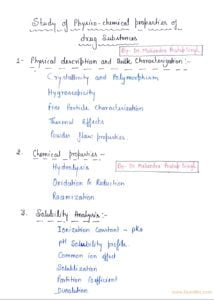Analytical method validation
www.DuloMix.com
At the end of this lecture, the student will be able to
• Explain analytical method validation
• Define the terms
• Precision
• Linearity
• LOD
• LOQ
• Range
www.DuloMix.com
What is Validation?
• Validation is defined as the process of demonstrating that the
analytical procedure is suitable for its intended purpose
Identification
Determination of impurities
Assay
www.DuloMix.com
Why Validation?
• The objective of any analytical measurement is to obtain
consistent, reliable and accurate data. Validated analytical
methods play a major role in achieving this goal.
• Validation of analytical methods is also required by most
regulations.l.
www.DuloMix.com
Typical Analytical Procedures To Be
Validated
• Four most common types of analytical procedures to be
validated:
• Identification tests
• Quantitative tests for impurities content
• Limit tests for the control of impurities
• Quantitative tests of the active moiety
www.DuloMix.com
Parameters
1. Linearity and Range
2. Specificity
3. Precision
4. Accuracy
5. Limit of Detection
6. Limit of Quantitation
7. Robustness
8. System Suitability
www.DuloMix.com
Characteristic Identifica Impurities Testing Assay
tion Quantitative Limit
Accuracy _ + _ +
Precision
a. Repeatability _ + _ +
b. Intermediate precision _ + _ +
Specificity + + + +
LOD _ _ + _
LOQ _ + _ _
Linearity _ + _ +
Range _ + _ +
-signifies that this characteristic is not normally evaluated
+ signifies that this characteristic is normally evaluated
www.DuloMix.com
Revalidation
• Revalidation may be necessary in the following circumstances:
• Changes in the synthesis of the drug substance
• Changes in the composition of the finished product
• Changes in the analytical procedure
www.DuloMix.com
1. Linearity and Range
• Ability to obtain test results that are directly (or by a well-defined
mathematical transformation) proportional to the concentration
of analyte in samples within a given range.
• The range of an analytical procedure is the interval between the
upper and lower levels of analyte (including these levels) that
have been demonstrated to be determined with a suitable level
of precision, accuracy, and linearity
www.DuloMix.com
Determination of Linearity and Range
• For establishment of linearity, minimum 5 concentrations are
recommended.
• Linearity results should be established by appropriate statistical
methods.
1
0.8
0.6
y = 0.0868x + 0.019
0.4
R² = 0.9988
0.2
0
0 2 4 6 8 10 12
www.DuloMix.com
Determination of Linearity and Range Cntd…
• Transformations are also acceptable and may include log, square
root, or reciprocal (other transformations are acceptable)
Conc. Response
(µg/ml) 1.8
1.6
1 0.0625 1.4
1.2 y = 0.3671x – 0.4296
1 R² = 0.9515
2 0.25 0.8
0.6
3 0.562 0.4
0.2
4 0.922 0
-0.2 0 2 4 6
5 1.562
www.DuloMix.com
Determination of Linearity and Range Cntd…
Conc. √Response 1.4
(µg/ml)
1.2
1 0.25 1
0.8
2 0.5
0.6 y = 0.246x + 0.004
R² = 0.9982
3 0.75 0.4
0.2
4 0.96
0
0 2 4 6
5 1.25
• If linearity is not attainable, a nonlinear model may be used. The
goal is to have a model (whether linear or nonlinear) that describes
closely the concentration-response relationship.
www.DuloMix.com
Determination of Linearity and Range Cntd…
• The following parameters should be determined:
✓ correlation coefficient
✓ y-intercept
✓ slope of the regression line
• The range of the procedure is validated by verifying that the
analytical procedure provides acceptable precision, accuracy, and
linearity when applied to samples containing analyte at the
extremes of the range as well as within the range.
www.DuloMix.com
2. Precision
• The precision of an analytical procedure expresses the closeness
of agreement (degree of scatter) between a series of
measurements obtained from multiple sampling of the same
homogeneous sample under the prescribed conditions
www.DuloMix.com
Concentration Absorbance Concentration Absorbance
0.28 0.21
0.31 0.32
10 µg/ml 0.29 10 µg/ml 0.39
0.30 0.53
Mean 0.29 Mean 0.36
Less Variation More Variation
High Precision Low Precision
www.DuloMix.com
• Precision may be considered at three levels:
Precision
Intermediate
Repeatability Reproducibility
Precision
www.DuloMix.com
1. Repeatability
• Repeatability expresses the precision under the same
operating conditions over a short interval of time.
• Repeatability should be assessed using a minimum of 9
determinations covering the specified range.
2. Intermediate Precision
• Intermediate precision expresses variations within
laboratories, such as different days, different analysts,
different equipment, and so forth
3. Reproducibility
• Reproducibility expresses the precision between
laboratories. It is assessed by means of an inter-
laboratory trial. (Defined as ruggedness in USP, ISO
17025)
www.DuloMix.com
• Following parameters should be reported:
a. Standard deviation
b. Relative standard deviation (coefficient of variation)
Concentration Absorbance SD & % RSD
µg/ml
0.337 0.00041, 1.2
1.223% 8
0.348 1
8 8
0.341 0.8 8
12
0.575 0.0106, 0.6
1.815% 12
0.583 0.4
12 12
0.596 0.2 20
20
0.967 0
20
0.0091, 4 8 12 16 20 24
0.985
20 0.933%
0.978
www.DuloMix.com
3. Accuracy
• Closeness of agreement between the conventional true value /
an accepted reference value and the value found.
High Accuracy Less Accuracy
(Less Precision) (High Precision)
www.DuloMix.com
Determination of Accuracy
1. Assay
Drug Substance
Drug Product
a) application of analytical a)application of the analytical
procedure to a reference procedure to synthetic
material mixtures to which known
quantities of the drug
substance have been added
b) to compare the results
b) to compare the results
c) accuracy may be inferred
once precision, linearity c) accuracy may be inferred
and specificity have been once precision, linearity and
established. specificity have been
established.
www.DuloMix.com
2. Impurities (Quantitation)
Assessed on samples (drug substance/drug product) spiked with
known amounts of impurities.
✓ Accuracy should be assessed using a minimum of 9 determinations
over a minimum of 3 concentration levels covering the specified
range (e.g., 3 concentrations/3 replicates each of the total
analytical procedure).
✓ Accuracy should be reported as percent recovery by the assay of
known added amount of analyte in the sample or as the difference
between the mean and the accepted true value.
www.DuloMix.com
4. Limit of Detection & Limit of Quantitation
• Limit of Detection:
• It is the lowest amount of analyte in a sample which can be
detected but not necessarily quantitated.
• Limit of Quantitation:
• It is the lowest amount of analyte in a sample which can be
quantitatively determined with suitable precision and accuracy.
www.DuloMix.com
Determination of LOD & LOQ
Limit of Detection Limit of Quantitation
Method Method
✓ Based on visual evaluation ✓ Based on visual evaluation
✓ Based on standard deviation ✓ Based on standard deviation
of response and slope of response and slope
LOD = 3.3 σ / Slope LOD = 10 σ / Slope
✓ Signal to noise ratio 2:1 or 3:1 ✓ Signal to noise ratio 10:1
www.DuloMix.com
www.DuloMix.com
6. Specificity
• The ability to detect the analyte of interest in the presence of
interfering substances (typically impurities, degradants, matrix).
1. Identification
• Suitable identification tests should be able to discriminate
between compounds of closely related structures which are
likely to be present.
• The discrimination of a procedure may be confirmed by
obtaining positive results from samples containing the analyte,
coupled with negative results from samples which do not
contain the analyte.
• The identification test may be applied to materials structurally
similar to or closely related to the analyte to confirm that a
positive response is not obtained.
www.DuloMix.com
2. Assay and impurity test:
a. Impurities are available
• For the assay , this should involve demonstration of the
discrimination of the analyte in the presence of impurities
and/or excipients.
• This can be done by spiking pure substances with
appropriate levels of impurities and/or excipients and
demonstrating that the assay result is unaffected by the
presence of these materials.
• For the impurity test, the discrimination may be established
by spiking drug substance or drug product with appropriate
levels of impurities and demonstrating the separation of
these impurities individually and/or from other components
in the sample matrix.
www.DuloMix.com
b. Impurities are not available
• If impurity or degradation product standards are unavailable,
specificity may be demonstrated by comparing the test results
of samples containing impurities or degradation products to a
second well-characterized procedure e.g. pharmacopoeial
method or other validated analytical procedure.
• As appropriate, this should include samples stored under
relevant stress conditions: light, heat, humidity, acid/base
hydrolysis and oxidation.
www.DuloMix.com
7. Robustness
• The robustness of an analytical procedure is a measure of its
capacity to remain unaffected by small, but deliberate variations
in method parameters and provides an indication of its reliability
during normal usage.
• If measurements are susceptible to variations in analytical
conditions, the analytical conditions should be suitably
controlled or a precautionary statement should be included in
the procedure, such as:
• Use solution within 24 hours
• Maintain temperature below 25 degrees
www.DuloMix.com
• In the case of liquid chromatography, examples of typical
variations are:
✓ influence of variations of pH in a mobile phase
✓ influence of variations in mobile phase composition
✓ different columns (different lots and/or suppliers)
✓ temperature
✓ flow rate
• In the case of gas-chromatography, examples of typical variations
are:
✓ different columns (different lots and/or suppliers)
✓ temperature
✓ flow rate
www.DuloMix.com
8. System Suitability
• System suitability testing is an integral part of many analytical
procedures
• The tests are based on the concept that the equipment,
electronics, analytical operations and samples to be analyzed
constitute an integral system that can be evaluated as such
www.DuloMix.com
Summary
• The precision of an analytical procedure expresses the
closeness of agreement (degree of scatter) between a series
of measurements obtained from multiple sampling of the
same homogeneous sample under the prescribed conditions
• Limit of Detection is the lowest amount of analyte in a sample
which can be detected but not necessarily quantitated
• Limit of Quantitation is the lowest amount of analyte in a
sample which can be quantitatively determined with suitable
precision and accuracy
www.DuloMix.com
Summary
• The robustness of an analytical procedure is a measure of its
capacity to remain unaffected by small, but deliberate variations in
method parameters and provides an indication of its reliability
during normal usage
www.DuloMix.com










